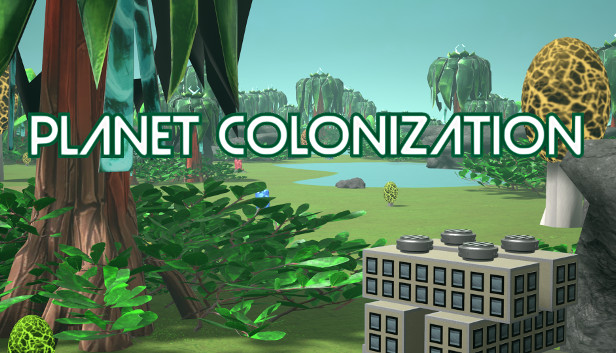1. Raw Materials on the Planet
In Planet Colonization the consumption and production of Raw Materials is directly connected to the market. This means that you don’t build transport routes for the goods and you don’t need to manage the storage space.
The Raw Material production buildings can only be placed on suitable resources. For example a Mine requires Ore deposit to be built on and Power to operate. The production chain of Ore looks like this:
Ore Deposit + Power -> Mine -> Ore Commodity -> Market -> Consumed by the Steel Factory




![]() ->
-> ![]()
The law of supply and demand applies to the prices of the Raw Materials. This concept is explained in more detail in the Industrial Production Guide.
The Strategic Importance of Raw Materials
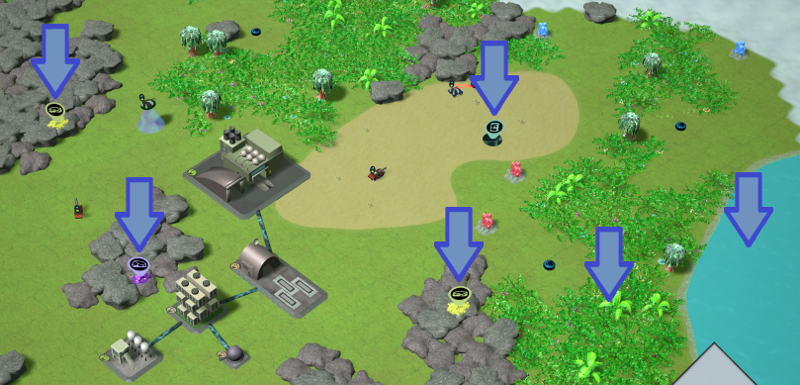
It’s very important to have access to as many natural resources as possible and the closer the resources are to your buildings the better it is.
The Industrial Buildings require a lot of Raw Materials and if there’s not enough production of them, the Raw Materials become expensive. This in turn takes the profitability away from the Industrial Buildings. Also, the colonists on the planet consume Staples like Food and Water of which they pay for themselves and without sufficient production the prices of these vital commodities get high and the life of the colonists gets tough.
If your Colony is the only one that can produce a specific Raw Material, you will probably benefit greatly from the high demand.
Depending on the position of your initial buildings on the planet, some of the Raw Materials may at times be difficult to reach. You may need to consider carefully how to place the colony buildings so that you don’t run out of Aether and you can protect them adequately.
Natural Resources
Following natural resources can be found on the planet
Limestone
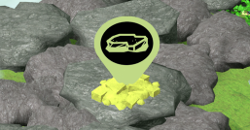
Limestone is one of the ingredients that is needed when producing Concrete. It’s occasionally found in Boulder Field and it can be produced by a Quarry.
Oil
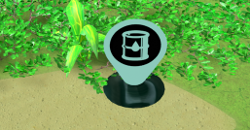
Oil is needed when producing Fuel. It’s occasionally found in Sand and it can be produced by an Oil Rig.
Ore
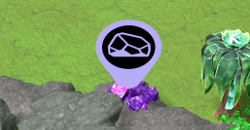
Ore is needed when producing Steel. It’s occasionally found in Boulder Field and it can be produced by a Mine.
Sand

Sand is one of the ingredients that is needed when producing Concrete. Sand is common on the planet.
Vegetation

Vegetation is needed for production of Food and Logs. Vegetation is common on the planet.
Water

Water is vital for the colonists. It’s also needed as ingredient in many production chains. There is Water on every planet, but sometimes it may be difficult to reach.
2. Raw Material Buildings and Production Chains
The Raw Material Buildings are usually located in the beginning of the production chain. They consume natural resources and produce Raw Materials that are automatically sold in the market. The colonists or other buildings then buy the Raw Materials from the market. To produce Raw Materials you must have access to appropriate natural resources on the planet.
Food Production

Vegetation + Water + Power -> Food -> Market -> Consumed by the Colonists




![]() ->
->
The Food Production building produces Food which is one of the essential basic Staples (Food, Water, Oxygen) that the Colonists consume. The Food Production building must be placed completely on Vegetation terrain type.
Gravel Pit
![]()
Sand + Power -> Sand (Commodity) -> Market -> Consumed by the Concrete Station



![]() ->
-> ![]()
The Gravel Pit produces Sand that is one of the ingredients needed to produce Concrete. The Gravel Pit must be placed on Sand terrain type.
Mine
![]()
Ore Deposit + Power -> Ore (Commodity) -> Market -> Consumed by the Steel Factory



![]() ->
-> ![]()
The Mine produces Ore that is needed for Steel production. The Mine must be placed on Boulder Field terrain type containing Ore deposit.
Oil Rig

Oil Deposit + Power -> Oil (Commodity) -> Market -> Consumed by the Refinery



![]() ->
-> ![]()
The Oil Rig produces Oil, which is often the most critical Raw Material. The buildings consume Power and Oil is the basis of the Power production chain. Oil is consumed by the Refinery. The Refinery then produces Fuel which is consumed by the Power Plant. The Oil Rig must be placed on Sand terrain type containing Oil deposit.
Quarry

Limestone Deposit + Power -> Limestone (Commodity) -> Market -> Consumed by the Concrete Station



![]() ->
-> ![]()
The Quarry produces Limestone that is one of the ingredients needed to produce Concrete. The Quarry must be placed on Boulder Field terrain type containing Limestone deposit.
Tree Production

Vegetation + Water + Power -> Logs -> Market -> Consumed by the Sawmill




![]() ->
->
The Tree Production building produces Logs that are needed for Lumber production. The Tree Production building must be placed completely on Vegetation terrain type.
Water Pump
![]()
Water + Power -> Water (Commodity) -> Market -> Consumed by Colonists, Food Production, Tree Production, Concrete Station and Oxygen Generator



![]() ->
-> 

![]() and
and ![]() and
and ![]()
The Water Pump produces Water which is one of the essential basic Staples (Food, Water, Oxygen) that the Colonists consume. Water is also needed to produce many of the commodities. The Water Pump must be placed on Water close to the shore.
3. Layout of Buildings
In Planet Colonization the buildings are connected to each other by Aether. Aether is a scarce resource that can be obtained by shooting Slimes. The natural resources may be some distance away from your other buildings and you often need to consider how to reach them using as little Aether as possible.
Compact Construction
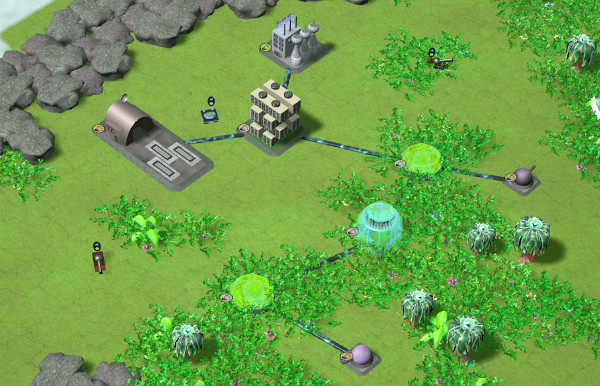
In the picture above, the Food Production and Tree Production buildings are located near the other colony buildings giving following advantages:
- The Aether connections are short.
- The buildings are easy to protect. In this case there are Tanks and Laser Turrets protecting the buildings.
Building Far from Others
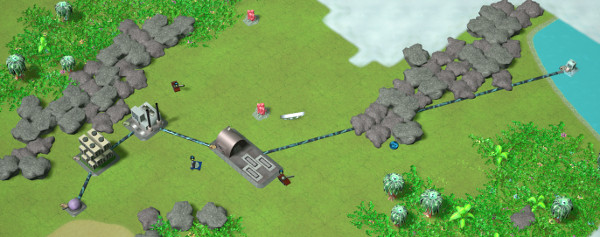
Here the Water Pump is quite far away from the other buildings. A lot of Aether has been spent to build the connection and if we wish to protect the building, it must be done separately. This is usually an undesirable situation, but can’t always be avoided.
Building Towards the Target
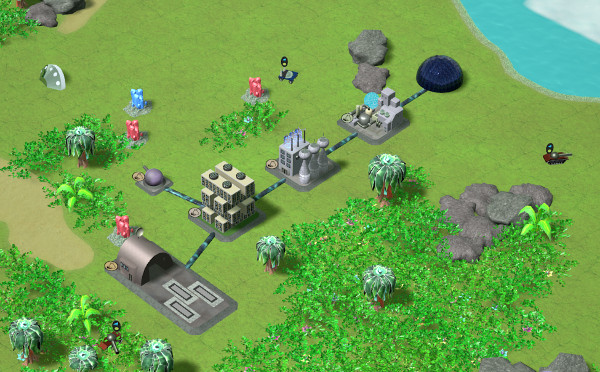
To reach the Water, we have already built an Oxygen Generator next to the Power Plant and we are now approaching the shore with one more new building. Laying out the buildings this way minimizes the Aether needed when we are going to build a Water Pump at some point later.
Reserving a Resource
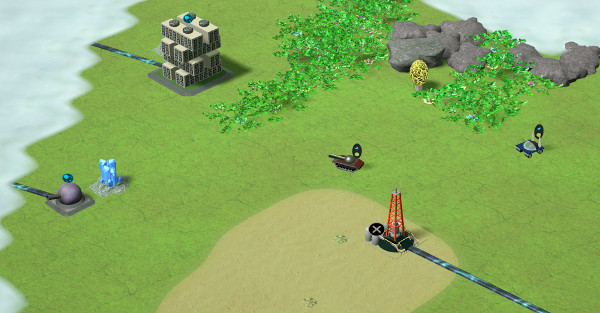
We have built an Oil Rig on the Oil Resource and then deactivated the building. This way it’s possible to reserve natural resources before the rival colonies. We can now wait for the right moment and activate the building when the price and demand of Oil are high.
Demolish to Restore Aether
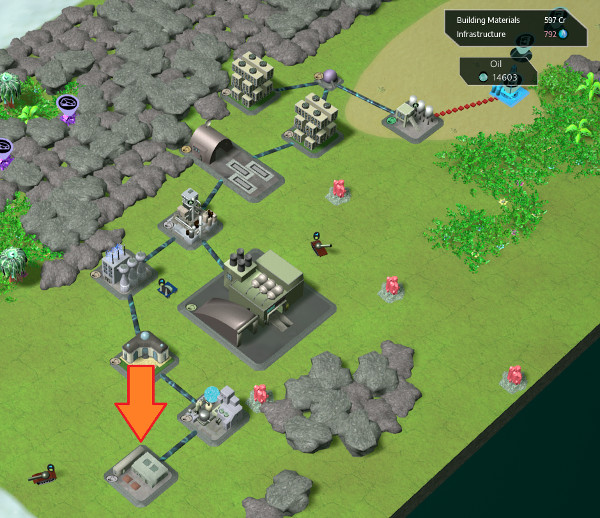
We would like to build an Oil Rig, but we don’t have enough Aether left. Demolishing a Sawmill building at the other end of the network will reduce the amount of Aether that is used by the Colony and we get some of it back. This gives us the possibility to build the Oil Rig right away without searching for more Aether. We still lose the value of building materials that were used to build the Sawmill.
4. Undermanning
Sometimes there are many possibilities for profitable production and you could build more workplaces than there are employees available. If the amount of workplaces exceeds the amount of workforce, there is inevitably undermanning in at least one building.
To see if there is undermanning, press the Building Info button on the bottom bar:
![]()
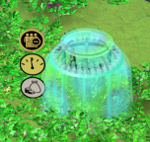
If there is a shortage of manpower, the Undermanning Symbol will appear on the left side of the building above the Efficiency Meter. The more red it is, the more there are empty workplaces.
Undermanning happens always first in the buildings that pay the lowest wage. The Colonists prefer to work in better-paying buildings.

We have opened the Budget Panel to see the wage distribution. The Tree Production building is paying the lowest wages of all existing buildings and is thereby undermanned. This can be fixed by moving the Tree Production higher on the list, but it doesn’t remove the shortage that will then be faced by the next building that now pays the lowest wage.
Advantages of Undermanning
- There’s no unemployment and you don’t need to pay Unemployment Benefit to prevent the negative effects of colonists’ declining wealth.
- If there are private buildings, they have to compete for labor. This leads to rising wages and colonists that are paid well may become customers of for example educational buildings or habitation modules.
Disadvantages of Undermanning
- The profitability of buildings tends to decline, because they need to compete for labor and raise wages.
- There is always at least one building that can’t get enough workforce.
- If there are private buildings, there is wage competition also between the public and private sectors.
5. Private Building Requests
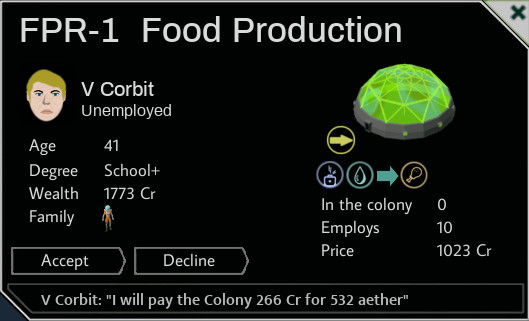
On the panel you can see:
– The Colonist who asked for the building permission.
– The type of the building and details
- Demand for the products of the building
- The production chain
- How many buildings of the same type are there already in the colony
- How many colonists the building will employ
- The price of the building. This will be paid by the Colonist who made the request.
You can also see how much Aether connecting the building will require and how much the Colonist pays for the Aether to the Colony. The price of Aether for private buildings can be set on the Budget Panel.
Clicking the Colonist’s name opens the Colonist’s Details Panel:
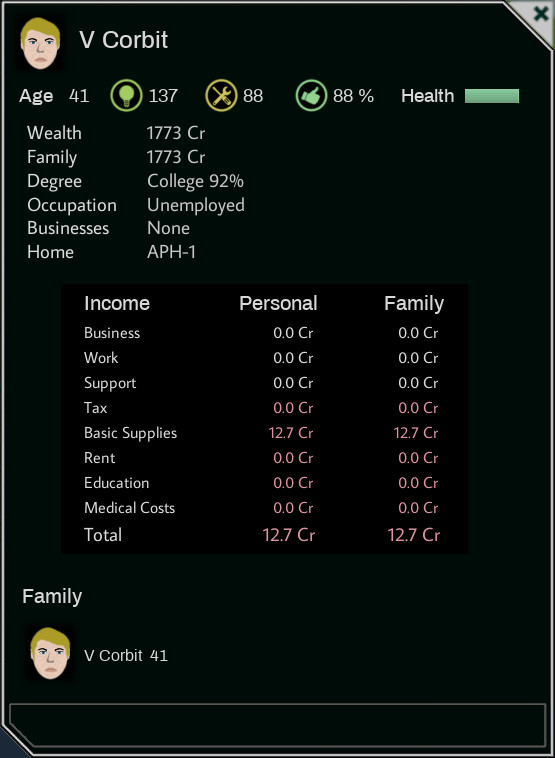
When the Building Request panel is opened, the area where the Colonist would like to build is highlited:
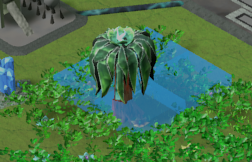
Also, the price development curves of the Commodities consumed and produced by the building are shown:

You have three choices:
- If you press the Accept button, the Building Request will be immediately accepted. A new building will be built and it’s now owned by the Entrepreneur.
- If you press the Decline button, the Building Request is rejected.
- If you just close the panel, the Colonist will wait for some time for your decision and then remove the Building Request.
To decide if the Building Request should be accepted, you can consider for example following things:
- The location of the building: Will it require too much Aether that you need elsewhere? Would you like to build something else on the site? Will the building be easy or difficult to protect?
- The expected profitability of the building: Is it important that the building will be profitable for a long time, or is it enough that it creates workplaces for the time being?
- Characteristics of the Entrepreneur: 25% of the buildings productivity depends on the Entrepreneur’s skills.
- Number of already existing buildings of the same type: If there’s overproduction, the price of the produced Commodity will decline and at some point all the buildings that produce the Commodity will become unprofitable.
- Undermanning and competition between the public and private sector: If the buildings owned by the colony need to compete fiercely for labor, it may have negative impact on public finances.
6. Resource Depletion
When you are constructing a Raw Material production building on a limited resource, the amount of resource available on the site is shown in addition to the construction costs: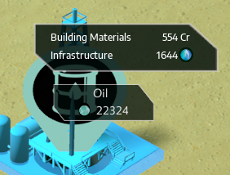
The building will produce as long as there is resource left on the site. However, eventually the natural resources will run out, the activity stops and the Depletion Symbol will appear on top of the building:
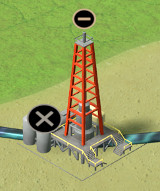
It’s usually a good idea to demolish the building at this point to get back the Aether that is reserved for the connections.
You may also choose to save the limited resources so that you can produce them when the rival colonies are running out of resources and the market situation becomes favorable. This can be done by deactivating the buildings or postponing the construction until later.
That’s all we are sharing today in Planet Colonization Production Guide – Raw Materials, if you have anything to addm please feel free to leave a comment below, and we’ll see you soon.
Credit to plcolonization
